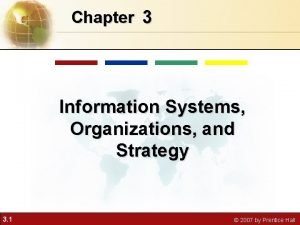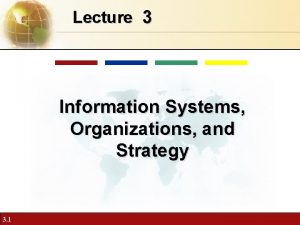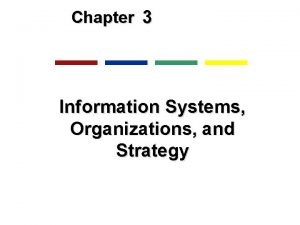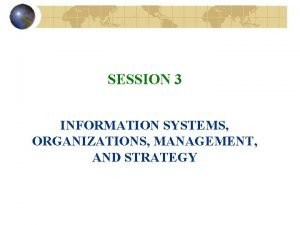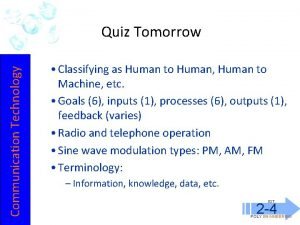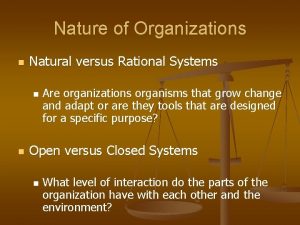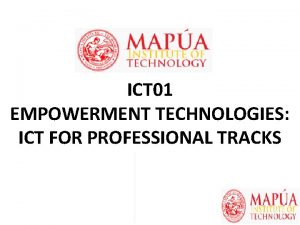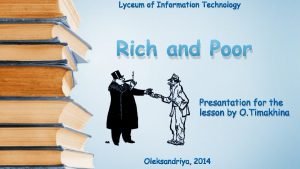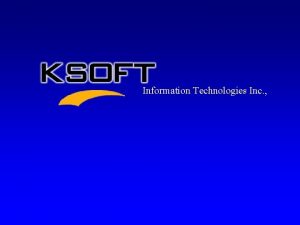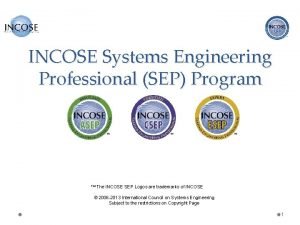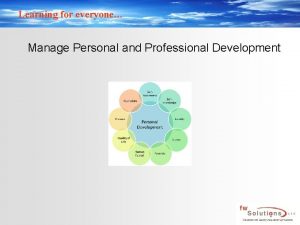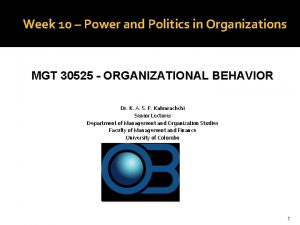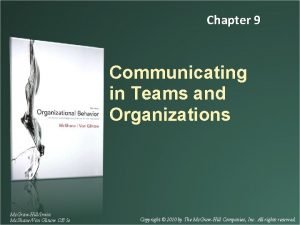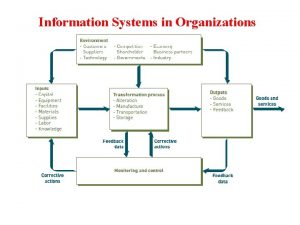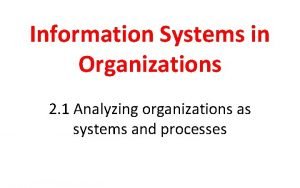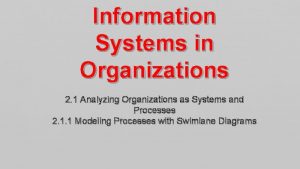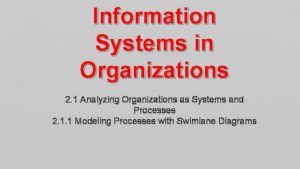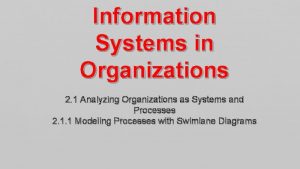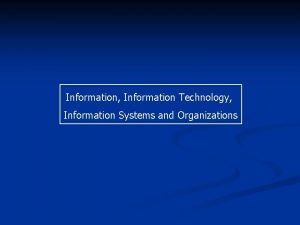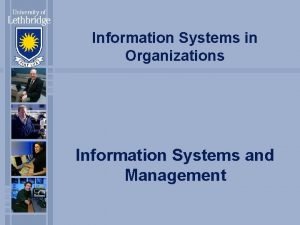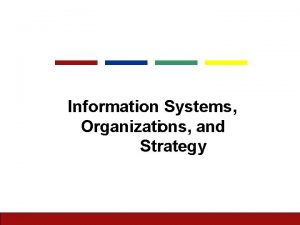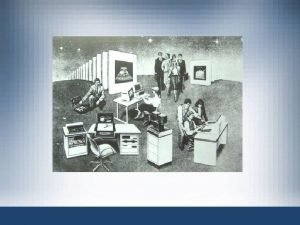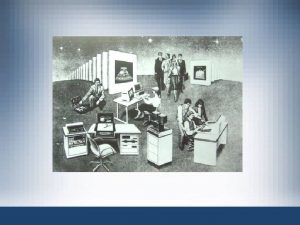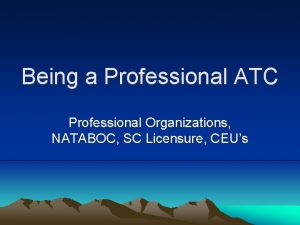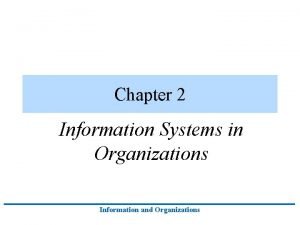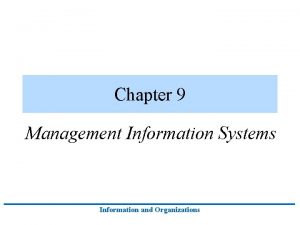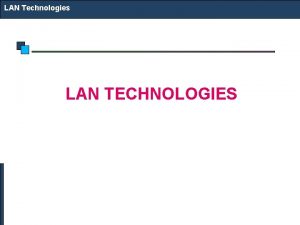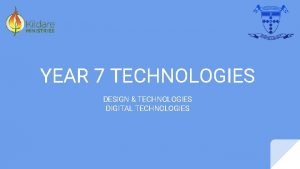Professional English Information Systems and Technologies ORGANIZATIONS AND
































- Slides: 32

Professional English Information Systems and Technologies

ORGANIZATIONS AND INFORMATION SYSTEMS Organization: • Stable, formal social structure • Takes resources from the environment and processes them to produce outputs

ORGANIZATIONS AND INFORMATION SYSTEMS

ORGANIZATIONS AND INFORMATION SYSTEMS • Collection of rights, privileges, obligations, and responsibilities • Delicately balanced over a period of time through conflict • Conflict resolution

ORGANIZATIONS AND INFORMATION SYSTEMS

ORGANIZATIONS AND INFORMATION SYSTEMS • Clear division of labor • Hierarchy • Explicit rules and procedures • Impartial judgments

ORGANIZATIONS AND INFORMATION SYSTEMS • Routines are patterns of individual behavior • Business processes are a collection of routines • Business firms are a collection of business processes

ORGANIZATIONS AND INFORMATION SYSTEMS

ORGANIZATIONS AND INFORMATION SYSTEMS • Structures • Goals • Constituencies • Leadership styles • Tasks • Surrounding environments

ORGANIZATIONS AND INFORMATION SYSTEMS

ORGANIZATIONS AND INFORMATION SYSTEMS The information systems department is responsible for maintaining: • Hardware • Software • Data storage • Networks

ORGANIZATIONS AND INFORMATION SYSTEMS Information Technology Services

ORGANIZATIONS AND INFORMATION SYSTEMS Includes Specialists: • Programmers: They are highly trained, who write the software instructions for computers • Systems analysts: Translate business problems into solutions, act as liaisons between the information systems department and rest of the organization • Information system managers: Leaders of various specialists

ORGANIZATIONS AND INFORMATION SYSTEMS • Chief Information Officer (CIO): Senior manager in charge of information systems function in the firm • End users: Department representatives outside the information system department for whom applications are developed

HOW INFORMATION SYSTEMS IMPACT ORGANIZATIONS AND BUSINESS FIRMS Economic Impacts: • IT changes both the relative costs of capital and the costs of information • Information systems technology is a factor of production, like capital and labor

HOW INFORMATION SYSTEMS IMPACT ORGANIZATIONS AND BUSINESS FIRMS Economic Impacts: • Transaction cost theory: Firms seek to economize on the cost of participating in markets (transaction costs) • IT lowers market transaction costs for firm, making it worthwhile for firms to transact with other firms rather than grow the number of employees

HOW INFORMATION SYSTEMS IMPACT ORGANIZATIONS AND BUSINESS FIRMS Organizational and Behavioral Impacts IT Flattens Organizations: • Information technology facilitates flattening of hierarchies • Broadens the distribution of timely information • Increases the speed of decision making

HOW INFORMATION SYSTEMS IMPACT ORGANIZATIONS AND BUSINESS FIRMS Flattening Organizations

HOW INFORMATION SYSTEMS IMPACT ORGANIZATIONS AND BUSINESS FIRMS Understanding Organizational Resistance to Change: • Information systems become bound up in organizational politics because they influence access to a key resource • Information systems potentially change an organization’s structure, culture, politics, and work • Most common reason for failure of large projects is due to organizational & political resistance to change

HOW INFORMATION SYSTEMS IMPACT ORGANIZATIONS AND BUSINESS FIRMS Organizational Resistance and the Mutually Adjusting Relationship between Technology and the Organization

HOW INFORMATION SYSTEMS IMPACT ORGANIZATIONS AND BUSINESS FIRMS The Internet and Organizations • The Internet increases the accessibility, storage, distribution of information and knowledge for business firms • The Internet lowers the transaction and agency costs of firms • Businesses are rapidly rebuilding their key business processes based on Internet technology. Example: online order entry, customer service, and fulfillment of orders

THE IMPACT OF IT ON MANAGEMENT DECISION MAKING Implications for the Design and Understanding of Information Systems Factors to consider while planning a new system: • Organizational environment • Organizational structure, hierarchy, specialization, routines, and business processes • The organization’s culture and politics

THE IMPACT OF IT ON MANAGEMENT DECISION MAKING • The type of organization and its style of leadership • Groups affected by the system and the attitudes of workers who will be using the system • The kinds of tasks, decisions, and business processes that the information system is designed to assist

INFORMATION SYSTEMS AND BUSINESS STRATEGY Value Chain Model: • Highlights the primary or support activities that add business value • A good tool for understanding strategy at the business firm level Primary Activities: • Directly related to the production and distribution of a firm’s products or services

INFORMATION SYSTEMS AND BUSINESS STRATEGY The Firm Value Chain and the Industry Value Chain

INFORMATION SYSTEMS AND BUSINESS STRATEGY Strategic question: • How can IT be used at each point in the value chain to lower costs, differentiate products, and change the scope of competition?

INFORMATION SYSTEMS AND BUSINESS STRATEGY The Value Web

INFORMATION SYSTEMS AND BUSINESS STRATEGY Information Systems Products and Services Systems that Create Product Differentiation: • Firms can use IT to develop differentiated products • Create brand loyalty by developing new and unique products and services • Product and services not easily duplicated by competitors

INFORMATION SYSTEMS AND BUSINESS STRATEGY Systems that Support Focused Differentiation: • Uses intensive analysis of customer data to support new ways of contacting and serving the customer • Enables development of new market niches for specialized products or services Example: Hotels frequent guest program

INFORMATION SYSTEMS AND BUSINESS STRATEGY Supply Chain Management and Efficient Customer Response Systems: Systems • These systems link your firm’s value chain to the value chains of your suppliers and customers • Directly links consumer behavior back to distribution, production, and supply chains • Example: Wal-Mart directly links customer purchases to suppliers in nearly real time. It is the suppliers’ job to ensure product is shipped to the store to replace purchased products

INFORMATION SYSTEMS AND BUSINESS STRATEGY Switching Costs and Lock-in Effects • IT is used at the firm level to discourage customers from switching to other suppliers, and “locking” them into a firm’s channels • Switching cost is the expense incurred by a customer or company for changing from one supplier or system to another

MANAGEMENT OPPORTUNITIES, CHALLENGES AND SOLUTIONS Challenges: • Some firms face big hurdles in implementing contemporary systems • Once an advantage is achieved, there are difficulties in sustaining the advantage • Organizations often cannot change fast enough to accommodate new technologies
 Information systems organizations and strategy
Information systems organizations and strategy Information systems, organizations, and strategy
Information systems, organizations, and strategy Information systems, organizations, and strategy
Information systems, organizations, and strategy Information systems organizations and strategy
Information systems organizations and strategy Chapter 3 information systems organizations and strategy
Chapter 3 information systems organizations and strategy Information systems and communication technologies quiz
Information systems and communication technologies quiz Organizations as natural systems
Organizations as natural systems Empowerment technologies ict for professional tracks
Empowerment technologies ict for professional tracks Dss systems and software technologies pvt. ltd.
Dss systems and software technologies pvt. ltd. Compendium of sanitation systems and technologies
Compendium of sanitation systems and technologies Current and future trends of media and information drawing
Current and future trends of media and information drawing Technologies for network based system
Technologies for network based system Utility systems technologies
Utility systems technologies Lyceum of information technologies
Lyceum of information technologies Tashkent information technology university
Tashkent information technology university Incvision
Incvision Ntic
Ntic Professional issues in cyber security
Professional issues in cyber security Incose certification
Incose certification Professional growth systems
Professional growth systems Csep exam questions
Csep exam questions Professional support system
Professional support system Incose asep exam
Incose asep exam Certified information technology professional (citp)
Certified information technology professional (citp) Manage personal and professional development
Manage personal and professional development Formal email requesting information
Formal email requesting information Ethical and social issues in information systems
Ethical and social issues in information systems Power and politics in organizations
Power and politics in organizations Voluntary health and welfare organization examples
Voluntary health and welfare organization examples Floral shops bookstores and farms are examples of
Floral shops bookstores and farms are examples of Formal groups fulfill both and functions in organizations.
Formal groups fulfill both and functions in organizations. Communicating in teams and organizations
Communicating in teams and organizations Power, politics and conflict in organizations
Power, politics and conflict in organizations
